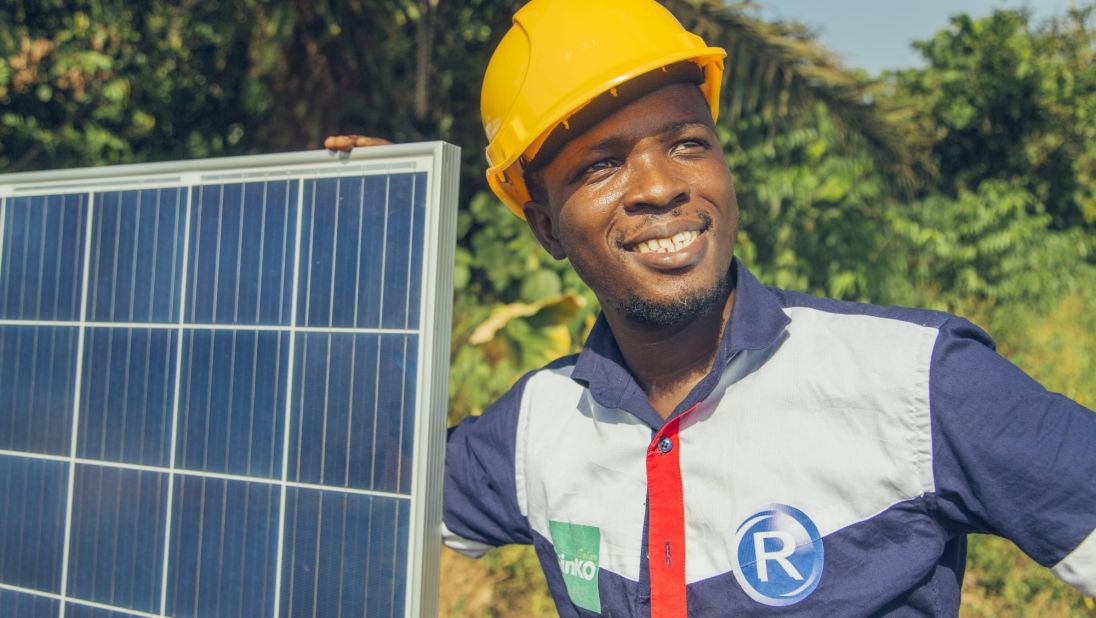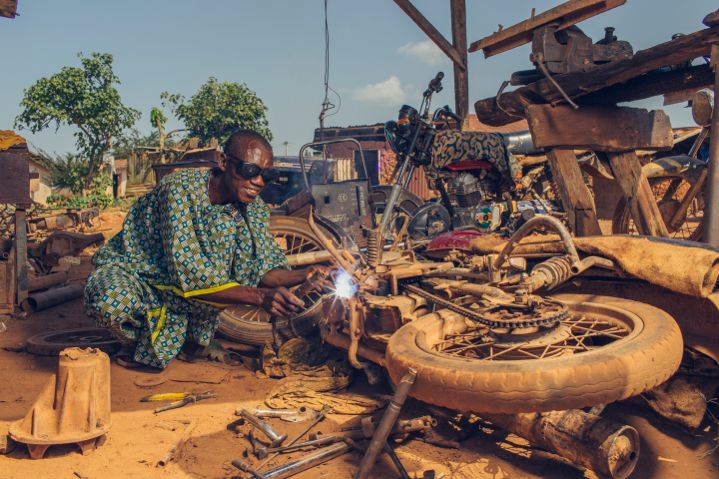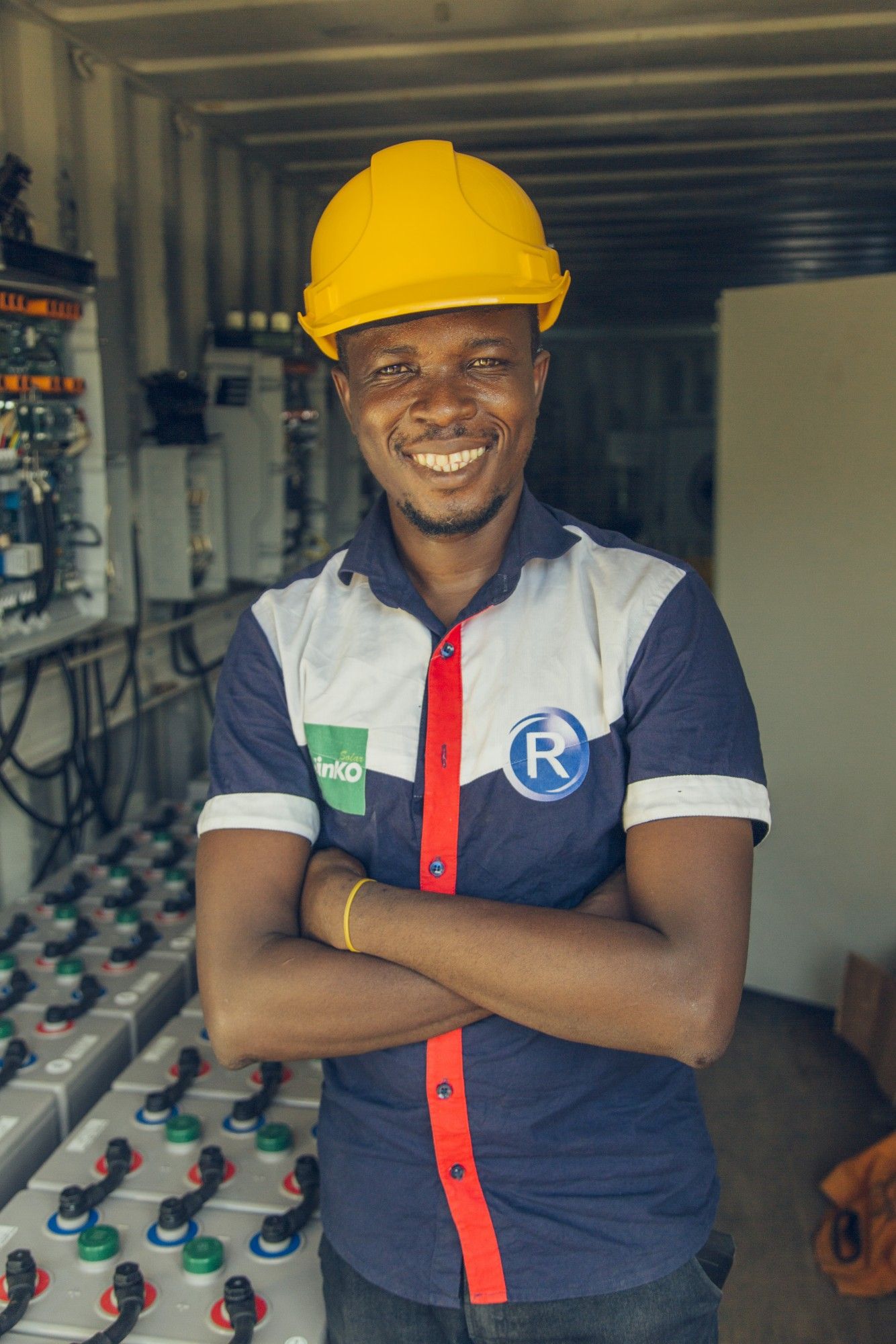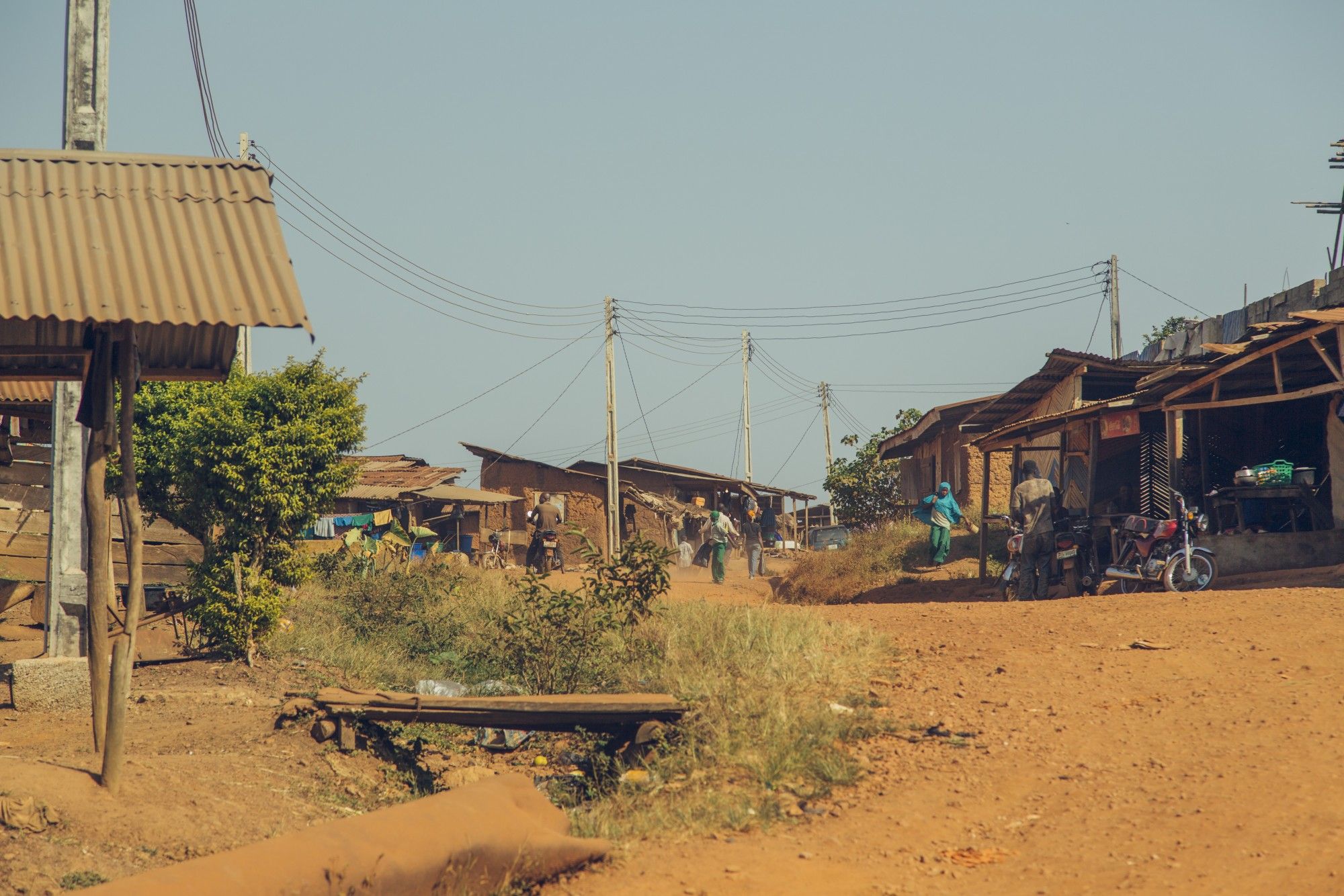|
Algeria
Angola
Benin
Botswana
Burkina Faso
Burundi
Cameroon
Cape Verde
Central Afr. Rep.
Chad
Comoros
Congo (Brazzaville)
Congo (Kinshasa)
Côte d'Ivoire
Djibouti
Egypt
Equatorial Guinea
Eritrea
Ethiopia
Gabon
Gambia
Ghana
Guinea
Guinea-Bissau
Kenya
Lesotho
Liberia
Libya
Madagascar
Malawi
Mali
Mauritania
Mauritius
Morocco
Mozambique
Namibia
Niger
Nigeria
Rwanda
São Tomé
Senegal
Seychelles
Sierra Leone
Somalia
South Africa
South Sudan
Sudan
Swaziland
Tanzania
Togo
Tunisia
Uganda
Western Sahara
Zambia
Zimbabwe
|
Get AfricaFocus Bulletin by e-mail!
Format for print or mobile
Nigeria/Global: Promising Potential for Solar Mini-Grids
AfricaFocus Bulletin
February 26, 2018 (180226)
(Reposted from sources cited below)
Editor's Note
In contrast to fossil fuels, which require transportation of fuel to generation
plants to produce electricity, and distribution networks to reach end-users of the
power, solar energy is eminently scalable and flexible, from portable lanterns all
the way to utility-scale photo-voltaic solar farms. Stand-alone off-grid systems can
power a single home or a school, and mini-grids can serve small communities.
The rapid expansion of battery storage has further enhanced the flexibility of such
systems. The village of Gbamu Gbamu in Ogun State, Nigeria, provides a "template"
that could be widely emulated in both technical and organizational terms, according
to a new article in the industry newsletter Greenteach Media.
The feature story in this AfricaFocus Bulletin highlights this village-level minigrid
with solar power and battery backup. Also included just below are brief excerpts
and links to recent updates on renewable energy developments, in the United States
(national and Puerto Rico), China, South Africa, and at the global level.
With the exception of policy regression at the national level in the United
States, the trend towards rapid expansion of renewable power is striking. In the
United States, despite the Trump administration, campaigns to move towards 100%
renewable energy and halt any new fossil-fuel projects continue to grow (see, for
example, https://gofossilfree.org/usa/
and https://www.sunrisemovement.org/).
The targets are not only fossil-fuel companies but also local, city, and state
governments and political candidates at all levels of government.
For a must-watch 4-minute video, with highlights of the "Fossil Free Fast" launch on January 31, 2018, see https://www.youtube.com/watch?v=wovzRGeaOR4.
For previous AfricaFocus Bulletins on climate change and renewable energy, visit
http://www.africafocus.org/intro-env.php
++++++++++++++++++++++end editor's note+++++++++++++++++
|
Recent Updates on Renewable Energy
- "How Trump’s Regulatory Rollback for America’s Energy Producers is Gaining Momentum," EnerKnol, Feb. 20, 2018
https://enerknol.com/ | direct URL: http://tinyurl.com/y9uc27de
- "Federal agencies have reacted quickly to President Trump’s executive order, issued
in March 2017, on reducing undue burdens on domestic energy production. On February
16, the Department of the Interior (DOI) announced the date for the largest sale of
oil and gas leases in U.S. history. Scheduled for March 21, the sale will include all
available areas in federal waters of the Gulf of Mexico. However, over the past year,
the administration’s push for deregulation has prompted numerous legal challenges
creating uncertainty in the industry."
- Emma Foehringer Merchant, "Grid Defection Is On the Rise in Puerto Rico," Greentech
Media, Feb. 16, 2018
https://www.greentechmedia.com – Direct URL: http://tinyurl.com/yd4bpw3v
- "This week, Sonnen and Pura Energía, a local solar installer, announced they’d
brought two storage-plus-solar systems online at SU Matrullas. Now, Castillo says
that teachers can use their computers, the school’s 150 students have enough light to
do homework, the school's kitchens have running refrigerators, and the community has
an off-grid center to help them weather the next storm. ... Even after grid-connected
power becomes available, said Castillo, the school plans to stay disconnected and run
on its own energy "
- Oliver Milman, "New York City plans to divest $5bn from fossil fuels and sue oil
companies," The Guardian, Jan. 10, 2018
https://www.theguardian.com/ - direct URL: http://tinyurl.com/y8k6uypd
- "City is seeking to lead the assault on climate change and the Trump administration
with a plan to divest $5bn from fossil fuels and sue the world’s most powerful oil
companies over their contribution to dangerous global warming. ...
De Blasio said that the city is taking the five fossil fuel firms – BP, Exxon Mobil,
Chevron, ConocoPhillips and Shell – to federal court due to their contribution to
climate change."
- Amy Myers Jaffe, "Green Giant: Renewable Energy and Chinese Power, Foreign Affairs,
March/April 2018
https://www.foreignaffairs.com/ - Direct URL: http://tinyurl.com/ya82rgk4
- "China aims to make itself the center of the clean energy universe, selling its goods
and services to help other countries avoid the environmental mistakes it now admits
were part of its recent economic growth. ... Just as China’s big move into solarpanel
manufacturing brought down the costs of that technology, so the prices of
batteries, electric cars, and carbon capture and storage will likely collapse as
China invests."
- Bloomberg, "Runaway 53GW Solar Boom in China Pushed Global Clean Energy Investment
Ahead in 2017," Jan. 16, 2018
https://about.bnef.com/ - Direct URL: http://tinyurl.com/yaq27e6m
-
"Solar investment globally amounted to $160.8 billion in 2017, up 18% on the previous
year despite these cost reductions. Just over half of that world total, or $86.5
billion, was spent in China. This was 58% higher than in 2016, with an estimated 53GW
of PV capacity installed – up from 30GW in 2016."
- Anton Eberhard & Amory Lovins, "South Africa’s Electricity Choice: Renewable Energy
is a win-win," Daily Maverick, Feb. 2, 2018
https://www.dailymaverick.co.za/ - Direct URL: http://tinyurl.com/yafublze
- "Importantly, most of South Africa’s R193-billion in renewable projects were financed
by banks and private investors, including R53-billion from abroad. It’s not hard to
see why: a solar plant built in sunny South Africa pays for itself twice as fast as
one in Italy. And while big renewable projects are very fast, small-scale renewable
projects, such as solar power for a home or a village, can be up and running within
weeks."
In Nigeria, a Template for Solar-Powered Minigrids Emerges
How a unique partnership, innovative financing and stubborn persistence created a model for localized solar and batteries.

by Chris Warren
Greentech Media, February 20, 2018
https://www.greentechmedia.com - Direct URL: http://tinyurl.com/y7dmflmj
On a humid November day in the small Nigerian village of Gbamu Gbamu
(pronounced bomb-ou bomb-ou), Akinola Oduola clambers down a wooden ladder
propped against a minaret that overlooks a tight cluster of adobe, wood and concrete
homes.
“This is my work,” Oduola says by way of introduction, gesturing toward
the mosque that is taking shape nearby.
This is not hyperbole. Oduola has spent the past three years single-handedly willing
this mosque into existence. Hard work is important for those who call Gbamu Gbamu
home. When he’s not building his mosque, Oduola is a welder and motorcycle
repairman -- an in-demand profession in a town where the bulk of the population
travels to and from Gbamu Gbamu along a deeply rutted 10-kilometer dirt road.
For Oduola, it’s the price of doing business: His ability to weld depends on a
generator that slurps between 30 and 35 liters of diesel per week.
But things are about to change dramatically for Oduola and a large percentage of his
3,000 fellow villagers, thanks to a construction project that has taken shape far
quicker than the mosque. From nearly any vantage point in Gbamu Gbamu, one can look
upward to see newly installed utility poles and wires.
This new distribution system will soon be delivering continuous power from a 30-
kilowatt installation of solar panels located on a nearby hillside that the local
government happily donated to the project’s developers, Lagos-based Rubitec
Solar. At night, a trailer full of batteries will keep the electricity flowing, and a
large generator will provide backup power in case the combination of solar and
batteries are ever unable to satisfy demand.
Akinola Oduola works on a motorcycle in Gbamu Gbamu.
Photo credit: Winrock International/Bobby Neptune.

Powering a better life
It’s hard to overemphasize what a change this newly installed minigrid
represents to a rural village in Nigeria. Access to power is one of Nigeria’s
most common and challenging chasms, a dividing line that determines a community
’s quality of life and prospects.
But by embracing a solar-powered minigrid, Gbamu Gbamu is set to vault past much
larger grid-connected urban areas in terms of reliable access to electricity. “
This fills an enormous unmet need in Nigeria. Half of the country is not on the
electrification network. The half that is connected receives very little electricity,
usually just a few hours' [worth] each day. And the other half may not be
connected for a decade, if ever,” says James Lykos, deputy director of the
Office of Economic Growth and Environment at the U.S. Agency for International
Development’s Nigeria mission, which has supported the development of Gbamu
Gbamu’s minigrid.
“When you have electricity, you can engage in better economic opportunities,
and it helps resolve poverty. This can have a transformative impact on rural
communities, and indeed, the country as a whole,” says Lykos.
Developing minigrids throughout Nigeria, including the one at Gbamu Gbamu, is one of
the main components of the Nigerian Energy Support Program (NESP), which is co-funded
by the European Union and the German government and is being implemented by GIZ, the
technical arm of the German Federal Ministry for Economic Cooperation and
Development. In addition to Gbamu Gbamu, five other minigrids have been developed
during the first phase of NESP. USAID partnered with GIZ to support two of the
minigrids, including the one in Gbamu Gbamu.
A minigrid model for Nigeria
In a country with an estimated population of 186 million, a single solar-powered
minigrid that is transforming a few thousand rural lives could understandably be
ignored as a happy novelty. But there’s something more profound taking shape.
The innovation, collaboration and persistence required to develop and construct these
minigrids have established a template that Nigeria can follow to deliver the benefits
of electrification to millions of people around the country.
Enthusiasm for minigrids is simply an acknowledgement of the economic and logistical
realities of Nigeria’s power grid.
“Extending the grid is very expensive. There are many communities -- most,
actually -- where extending the grid is a net present value-losing proposition. You
will never get enough money out of these communities to justify doing this,”
says Javier Betancourt, the chief of party for the USAID-funded Renewable Energy and
Energy Efficiency Project (REEEP) in Nigeria, which is being implemented by the U.S.-
based NGO Winrock International.
“You can’t electrify everybody using the grid or large-scale generation.
The best solutions are minigrids. This is the future. But there needs to be a
template in Nigeria for how this is going to evolve,” says Betancourt.
Devising and implementing a replicable template has been the core mission of REEEP
since its launch in 2013. The challenges and roadblocks have been daunting.
While minigrids may be the best and only solution for electrifying Nigeria, their
development has been stunted for a host of reasons, including the lack of technically
competent minigrid designers and solar installers.
“There’s a very large problem in Nigeria with faulty installations that
have created this perception problem,” says Betancourt. “There are all
these dead solar systems all over the place that have given people the impression
that solar doesn’t work, and it’s usually due to shoddy installation
work.”
To address this immediate problem and build a skilled workforce, REEEP and GIZ worked
with dozens of international experts to develop a rigorous and standardized
curriculum that is now used at 13 training institutions across Nigeria.

Alabi Abiodun of Rubitec Solar shows off the batteries powering the Gbamu Gbamu
minigrid. Photo credit: Winrock International/Bobby Neptune.
Budding Nigerian minigrid developers and investors also needed assistance figuring
out which communities could feasibly support a minigrid. In part, that meant finding
villages that were far enough away from the power grid that there was no chance that
it would be extended anytime in the near future. More importantly, developers and
investors needed to know which villages had sufficient population and economic
activity to make the investment required to build a minigrid worthwhile.
“Are there productive activities going on to show that they have the capacity
to pay for the cost of electricity?” says Anayo Okenwa Nas, the CEO of Nayo
Tropical Technology Ltd., a developer of minigrids in Nigeria. “Is it a fishing
community? A timber community? An agrarian processing community?”
To help developers focus their attention and resources on viable sites, GIZ performed
geographic information system data analysis in five Nigerian states to locate which
villages had sufficient load to justify a minigrid. This work has resulted in a tool
that will soon be launched by the Nigerian Ministry of Power that developers and
investors can use to streamline their efforts. “If I want to set up a project
in Nigeria, I can quickly see whether it makes sense to invest and where,” says
Ina Hommers, who heads up NESP for GIZ. “This is something we want to expand
because no investor has time or money to do this from scratch.”
The biggest hurdle of all: Money
Of all the obstacles standing in the way of solar-powered minigrids delivering the
benefits of electricity to millions more Nigerians, none has been as complicated and
challenging to address as financing. Anyone considering building a minigrid would
have to find money to pay for both the solar panels and batteries required to
generate and store electricity as well as the poles, wires and meters necessary to
distribute it to homes and businesses.
These combined costs make it impossible for minigrid developers to attract investors.
But it’s also not a financial burden that generation companies around the world
are typically expected to cover. “They never pay for their own distribution,
” says Betancourt. “If you think about it fairly, nobody in any country
has ever paid for their own grid. Generation companies get the grid through a subsidy
or the government, or someone comes in with a grant and gives the thing away.”
To address this challenge, REEEP and GIZ devised what Betancourt describes as the
“split asset model.” Instead of trying to convince banks and other
financial institutions to invest in a minigrid project as a whole, REEEP separated
the distribution and generation components. For the first five minigrid projects in
Nigeria, including in Gbamu Gbamu, GIZ provided a grant to cover the distribution
costs, which account for roughly half of the total project expenses.
REEEP and GIZ initially turned to Nigeria’s central bank and commercial banks
to provide funding that developers needed for the solar panels, batteries and other
generation components required for the minigrids. Because renewable energy is a
nascent industry in Nigeria, this first meant educating bankers about how to evaluate
potential minigrid projects.
“We provided training with banks on small renewable energy projects. Banks don
’t usually understand the rationale of such projects,” says GIZ’s
Hommers. “You can’t really count on the experience of other projects
because the sector is so young. To banks, that is very high risk.”
Though there’s optimism that the extensive outreach and education REEEP and GIZ
provided to Nigerian banks and other investors will facilitate project financing in
the future, an economic collapse and devaluation of the country’s currency in
2015 quickly halted all the progress that had been made. “Everything came
crashing down exactly when we were going to get our first minigrid financed,”
says Betancourt. “For two years, we were stumped on how to get them financed.
”
Crowdfunding to the rescue
But that all changed when Betancourt met a representative of the German crowdfunding
platform Bettervest at an event in Lagos. Bettervest allows individuals to invest and
earn a return on renewable energy and energy efficiency projects around the world.
The crowdfunding platform was exploring an entry into the Nigerian market and had
formed a partnership with GIZ to help it understand the unique dynamics at play in
the country. “Bettervest had a very strong interest to pilot two projects
before deciding if they wanted to enter the Nigerian market for other activities,
” says Hommers.
Though GIZ was eager to find financing for the pilot minigrids, it was also reluctant
to expose Bettervest’s investors to any unnecessary risk. “We lack the
financial ability to say this is safe and sound,” says Hommers. Instead, GIZ
relied on the financial expertise of REEEP’s Betancourt. Betancourt had worked
previously as an investment banker, a financial regulator for the Mexican government
and for NGOs like Winrock, where one of his specialties over the past decade has been
improving access to finance in the developing world.
Betancourt applied all of that experience to help Bettervest lower (though not
eliminate completely) the risk faced by its investors. “I do the financial due
diligence for them here. I provide Bettervest the credit reports, the tax clearances,
the reputational checks and the document verification,” he says. “GIZ
helped them with lawyers to get contracts and together we lowered their entry costs.
That is how we got them to finance our minigrid projects.” Once actually posted
to the Bettervest website, it took 106 days for investors to pony up the 224,100
euros (around $260,000) required for Rubitec to build the generation component of the
project. Bettervest investors are expecting a 10 percent return on their investment
in Gbamu Gbamu.
A sustainable model for the future?
Though the pilot minigrid projects GIZ and REEEP have helped shepherd into existence
will clearly have a big impact on the communities where they are located, the obvious
question is whether this development approach can be scaled up. Though REEEP is
coming to an end in early 2018, GIZ has already committed to provide grants that will
cover the distribution costs of 20 more minigrids.
Obviously, GIZ and other donors can’t supply grants for the thousands of
minigrids Nigeria will need to bring clean and reliable electricity to all of its
citizens. Betancourt has been working with both the Nigerian Rural Electrification
Agency as well as individual state governments to explore ways to take funds
typically devoted to extending the central grid and use it instead for minigrids.
“Each state government gets a grid extension budget from the federal government
each year to extend the grid,” Betancourt says. “What they can do now is
use that budget to give grants to the project developers for the distribution and the
metering and the Nigerian minigrid developers do the rest on a purely commercial
basis.”
In other words, it’s a way to utilize the so-called “split asset model
” to develop the minigrid in Gbamu Gbamu over and over again. “We believe
these minigrids strongly prove there is private-sector interest. This is a bit of a
game-changer in sub-Saharan Africa,” says Hommers.
There are certainly challenges ahead. The risk of devaluation of the Nigerian
currency, the naira, is always a worry for investors. Corruption also remains a major
problem. Training legions of skilled solar installers and minigrid designers will be
of little use if there aren’t projects for them to work on. “A lot of
this will atrophy if the people who were trained don’t get to utilize their
skills and work and bring renewable energy projects to completion,” says USAID
’s Lykos.

The new distribution system in Gbamu Gbamu. Photo credit: Winrock
International/Bobby Neptune.
In many ways, though, the future of solar-powered minigrids in Nigeria will depend on
the success of people like Bolade Soremekun. Soremekun is the CEO of Rubitec Solar,
the company that built the Gbamu Gbamu minigrid. Soremekun earned an MBA at New
York University and spent years working for big multinational corporations like
Johnson & Johnson and GlaxoSmithKline. But he always wanted to come home to
Nigeria. “I wanted to achieve and do things in Nigeria,” he says.
For years, working in solar meant organizing conferences, an admittedly time-
consuming and money-losing hobby compared to Soremekun’s successful
pharmacy business. “My pharmacy staff once called a meeting and said, 'Stop
this crazy thing you are doing about organizing conferences,'” he says.
“'You are promoting solar, good, but you are not making money.'”
Lately, though, solar and minigrids are looking more and more attractive. It used to
be that meetings with banks would frustrate Soremekun because they would either not
offer financing at all, or would only offer it at exorbitant interest rates. That has
already started to change. Soremekun believes it will change faster once bankers see
the reliable cash flow that will be generated when customers in Gbamu Gbamu prepay
their electricity bills using mobile money accounts.
“I think if the pilots go well, and I hope they do, they are going to start a
momentum towards minigrids,” he says. “I think financing will be easier.
The banks are going to see the cash flow right there in front of them, and they
’ll say, 'OK, we want to do the next minigrid and then the next
minigrid.'”
Rubitec already has plans to construct between five and 10 minigrids over the next
two years, with 100 other potential sites already pinpointed. With more and more
projects, Soremekun believes minigrids will become easier to develop and implement.
“What attracts investors to minigrids is scale. They don’t want one
minigrid; they want hundreds of them. Then it becomes a good business,” he
says. “Solar is the best space to be in right now in terms of business, I
think. There are so many huge opportunities.”
Minigrids have allowed Soremekun to make the kind of difference that compelled him to
return to Nigeria. At first, people in Gbamu Gbamu didn’t really believe the
minigrid would actually be built. “There are too many promises that are not
fulfilled,” he says. “They have just accepted their fate, to live their
lives as best they can. This changes that. Their lives could be better. That’s
why I get up every morning excited.”
***
Chris Warren is a freelance writer based in Arkansas. The reporting trip to
Nigeria was funded by Winrock International.
AfricaFocus Bulletin is an independent electronic publication providing reposted
commentary and analysis on African issues, with a particular focus on U.S. and
international policies. AfricaFocus Bulletin is edited by William Minter.
AfricaFocus Bulletin can be reached at africafocus@igc.org. Please write to this
address to suggest material for inclusion. For more information about reposted
material, please contact directly the original source mentioned. For a full archive
and other resources, see http://www.africafocus.org
|
